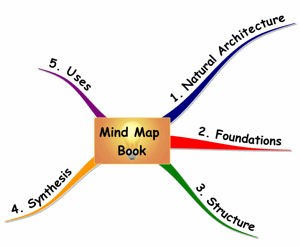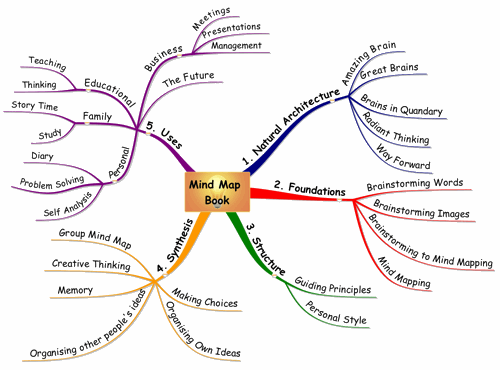How to Mind Map a Text Book
How to Mind Map a Text Book is often asked when having to learn large volumes of information.
Mind Maps in Education started with "Using Mind Maps for note taking as an alternative to Linear Note Taking.
Using Mind Maps as part of a study method is still one of the most popular applications of Mind Maps and Mind Mapping.
By using Mind Maps for notes, you can reduce volumes of writing to a single page.
The main idea behind the use of Mind Maps as study notes, is not simply to make notes on the subject, but to actually organise the notes. The structure of the notes should reflect their original thought of the author and, if possible, reflect your thoughts on the matter.
We will look at how to Mind Map a Text Book, as an example.
You can use this method to Mind Map most non fiction books, as they normally have a good structure, with a table of contents. Some of them are even divided into divisions or sections to make your life even easier.
We will use the Mind Map Book by Tony Buzan, the inventor of Mind Maps as our sample book.
Subscribe to Using Mind Maps
Get Access to the Best Mind Mapping Tips, Tools, Techniques Resources and Opinions.
1. Browse through the whole book
Pretend you have half an hour in a book store and you are browsing through the book. One of the secrets to learning how to Mind Map a text book, is to not start immediately with your Mind Map notes. First survey the scene and get a good idea of the task at hand.
- Look at the contents of the book
- Check to see whether the book divided into sections or parts
- Look at the chapter headings
Now flip through the pages.
- Try to get a feel for the structure of the book
- Check to see how the chapters are structured
- Look at the diagrams and tables
- Check to see whether each chapter has objectives or outcomes
- Check whether there are summaries at the beginning/end of each chapter
- Check whether questions on the subject matter are included in the text
Take a short break.
2. Mind Map your thoughts and what you know about the subject
Another secret when learning how to Mind Map a text book is to first Mind Map your own thoughts, before your start with Mind Mapping the book.
You may think this sounds crazy, but it is of the utmost importance. The main principle behind learning is to go from the known to the unknown. Mind Mapping what you know may surprise you. It will also serve as a platform to learning the material.
- Use no more than 5-10 minutes for this exercise
- Mind Map whatever comes to mind about the subject
- Don't overthink it
- If you find you have hit a blank, don't worry. You will get better at this.
3. Mind Map an Overview
If the book is divided into sections, put this on a single Mind Map.
- Use a central image that represents the subject.
- Put each section on a new branch.
- Uses Key Words if the chapter headings are long.
- Number the chapters.
You now have a Structured Overview of the book.

3. Mind Map a Detailed Overview
In the detailed overview, you are going to do one chapter at a time. Each chapter gets its own Mind Map. I generally spend a session on each chapter and often build up a collection of chapter overviews over the course of my study. Many people prefer to do a detailed overview at the beginning of their studies. The choice is yours.
In either case, you will end up with the same thing - a detailed overview of the text book.
- Use a central image to represent the chapters
- Look at sub-headings and use these for the branches
- Add pictures wherever possible
At this point, you should be amazed at what you already know about the subject. You are now ready for the details.

4. Mind Map the Details
I normally map the details on a copy of the Detail Overview Map. I keep both, as I like to have the detailed overview on a separate Mind Map for quick, 1-2 mind reviews. I find that this greatly increases my recall ability.
- Add details to each branch
- Keep details at one level below the subheadings if possible
- Continue to add pictures wherever you can
Most people find that 90% of their studying is already done at this stage. And you haven't even started to study yet! You have just organised your notes in preparation for studying!
If this article is a bit advanced for you, have a look at our Introduction on How to Mind Map, or our How to Mind Map in Seven Steps article. You can also have a look at the Mind Map examples on this site to help you learn the Mind Map Principles.
Whatever route you choose, ensure that your take the full advantage of Mind Maps in Education.
Click here to learn about our unique Learning Management Program...
